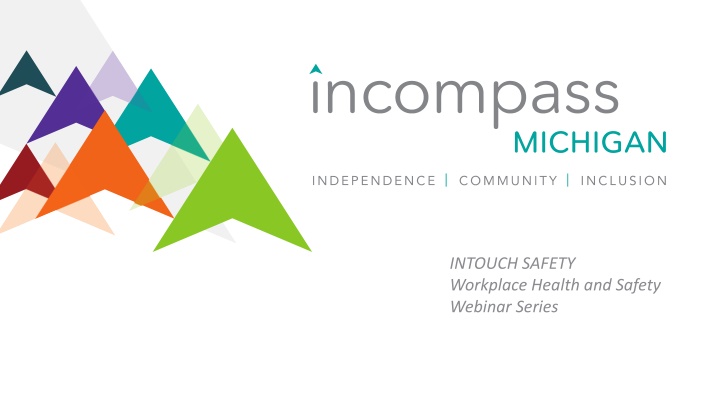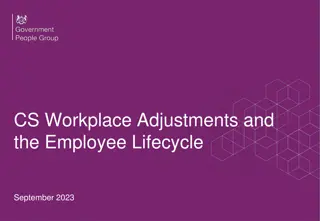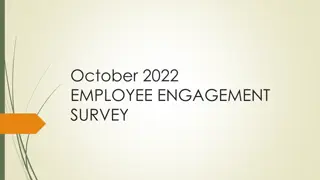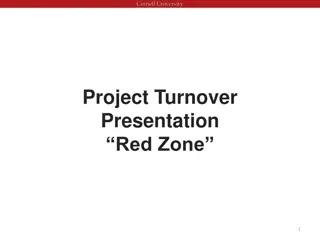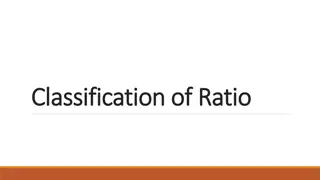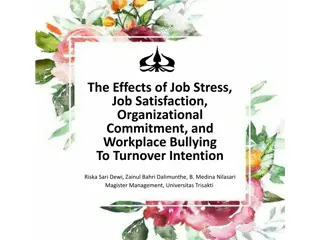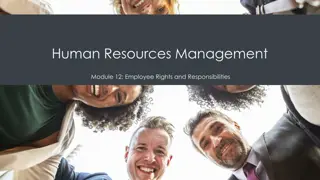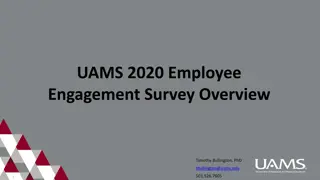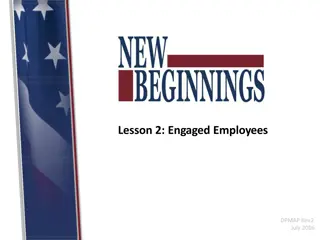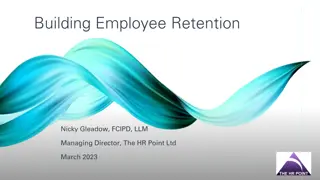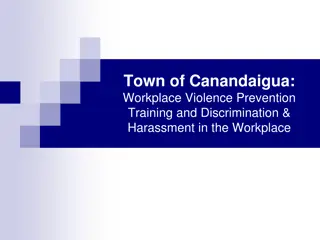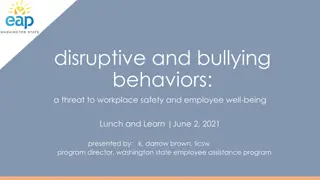Impact of Employee Engagement on Workplace Safety and Turnover Trends
Explore the connection between declining employee engagement, increased turnover rates, and workplace safety implications. Learn how disengagement can lead to higher injury risks, elevated costs, and a disconnect between employees and their work environment. Discover strategies to bridge this gap and improve overall safety culture.
Download Presentation

Please find below an Image/Link to download the presentation.
The content on the website is provided AS IS for your information and personal use only. It may not be sold, licensed, or shared on other websites without obtaining consent from the author.If you encounter any issues during the download, it is possible that the publisher has removed the file from their server.
You are allowed to download the files provided on this website for personal or commercial use, subject to the condition that they are used lawfully. All files are the property of their respective owners.
The content on the website is provided AS IS for your information and personal use only. It may not be sold, licensed, or shared on other websites without obtaining consent from the author.
E N D
Presentation Transcript
Safety PPT INTOUCH SAFETY Workplace Health and Safety Webinar Series
The Impact of Employee Engagement on Workplace Safety Presenter: Todd Culver, President and CEO Incompass Michigan
INTOUCH SAFETY Training Project in Partnership with MIOSHA CET Division This material was prepared under a Consultation Education and Training (CET) Grant, awarded by the Michigan Occupational Safety and Health Administration (MIOSHA). MIOSHA is a part of the Department of Labor and Economic Opportunity (LEO). Points of view or opinions stated in this document do not necessarily reflect the view or policies of LEO.
SAFETY and EMPLOYEE ENGAGEMENT Declining employee engagement trends Recent history of increased employee turnover How does this impact culture? How does this impact workplace safety?
Declining Employee Engagement Gallup poll shows declining engagement since 2019 Measures include clarity of expectations, opportunities for development, and feeling heard and cared about Involved and enthusiastic Disengagement can mean disgruntled, disloyal, disaffected Fault finding rather than solution seeking; less interest in contributing to all aspects of positive work environment; inattentive to workplace conditions
Increased Turnover Acknowledging the Great Resignation 51million employees quit their jobs in the US in 2022 If employee expectations are not met, retention suffers Inclination to leave or change jobs elevates, rather than active interest in staying and progressing Higher turnover results in increased costs and elevated risks Costs estimated at 33% of base pay, and new hires replacing those who left experience higher rates of injury From 2016-2020, 34 percent of workplace injuries happened during an employee's first year on the job. These injuries triggered nearly 7 million missed workdays.
Bridging the Disconnect Studies have shown that employees are feeling more disconnected from their work than ever before Impact of COVID, embrace of hybrid and remote work Traditional engagement strategies losing traction 79% of employees prefer a job with recognition over a job that pays more, but lacks that recognition 40% indicate likelihood of looking elsewhere if not recognized
How These Trends Impact Workplace Culture Harvard Business Review: Looking ahead, successful businesses will turn their attention from recruitment to retention Employers rising to the top will be those that respond to new employee expectations, such as encouraging internal talent mobility and upskilling offering flexible hybrid and remote work options providing more effective, personal support for employees and managers as they navigate these dynamically changing times
And It Starts Right Away Employees don t develop the premise that these are valued characteristics over time they begin with them (flexibility, opportunity for development, meaning) Onboarding can include opportunity mapping, resources to promote physical and mental health, and workplace health and safety messaging to support the sense of employee wellbeing This can help your organization recognize cultural alignment, as well as talent, right away Leading to higher retention rates With fewer new employees, rates of injury can decrease
How These Trends Impact WORKPLACE SAFETY It is generally accepted that workplace safety has improved over time advancements in technology and improved processes and methods Increased regulatory oversight However, BLS data indicates non-fatal injury rates have remained static for the last several years In addition, NSC data indicates the number of unreported injuries appears to be increasing
How These Trends Impact WORKPLACE SAFETY Some labor observers have become concerned that safety has taken a back seat thus far in the post-COVID-19 era Recovery is front of mind for so many employers Physical and mental health Challenging economic conditions and shifting headwinds Discovering that traditional approaches are no longer as effective for conditions like employee engagement Need to recognize that employers approach to safety requires adjusting to this new environment of employee expectations, and acknowledge the fallout when not met Both economic and employee wellbeing
How These Trends Impact WORKPLACE SAFETY Employees who don t feel appreciated don t stay And employees who don t stay will not have the opportunity to assimilate safety best practices, or be a part of instilling safe behaviors among newer workers. This is how culture and safety are woven together
How These Trends Impact WORKPLACE SAFETY Businesses should include safety in the broad framework of employee appreciation The traditional model of simply preaching safety protocols, or punishing unsafe behaviors, may no longer be effective Instead, rewarding employees for demonstrating their knowledge of relevant safety issues may be beneficial Also less likely to underreport
How These Trends Impact WORKPLACE SAFETY Even safety issues like accident or near miss reporting can be viewed as a net positive for employers, so that procedures can be modified, and best practices implemented, using more accurate information Employees should be encouraged to think of safety, and safety reporting, as a positive aspect of helping themselves and their colleagues, and making the organization a better place to work Safety protocols improve, fewer employees are injured and employers remain healthier and more competitive in the long run
HEALTH AND SAFETY PROGRAM BENEFITS Safety and health programs help businesses: Prevent workplace injuries and illnesses Improve compliance with laws and regulations Reduce costs, including significant reductions in workers' compensation premiums Engage workers Enhance their social responsibility goals Increase productivity and efficiency, enhancing overall business operations
CONCLUSION How is safety woven into the fabric of your organization s culture? Have you considered employee engagement strategies, and the accompanying impact on both safety and culture? Have you viewed reducing turnover through the lens of improving employee health and safety?
Thank You stay safe and healthy! Incompass Michigan remains committed to being a trusted resource for getting connected and staying informed.
MIOSHA Strategic Plan https://www.michigan.gov/- /media/Project/Websites/leo/Documents/MIOSHA15/lara_miosh a_goals_fy1923.pdf?rev=f5995cd8617d43daadb021d8de874688 Occupational Safety and Health Magazine, Safety Starts with Engagement https://ohsonline.com/Articles/2023/06/30/Safety-Starts-with- Engagement.aspx?admgarea=ht.HumanResources&Page=1 RESOURCE CITATIONS Gallup, US Employee Engagement Needs a Rebound in 2023 https://www.gallup.com/workplace/468233/employee-engagement- needs-rebound-2023.aspx Harvard Business Review, 9 Trends that Will Shape Work in 2023 and Beyond https://hbr.org/2023/01/9-trends-that-will-shape-work-in-2023-and- beyond Society for Human Resource Management, New, Older Workers Stand Out in Workplace Injury Data https://www.shrm.org/resourcesandtools/hr-topics/risk- management/pages/new-older-workers-workplace-injury-data.aspx
INTOUCH SAFETY Training Project in Partnership with MIOSHA CET Division This material was prepared under a Consultation Education and Training (CET) Grant, awarded by the Michigan Occupational Safety and Health Administration (MIOSHA). MIOSHA is a part of the Department of Labor and Economic Opportunity (LEO). Points of view or opinions stated in this document do not necessarily reflect the view or policies of LEO.
